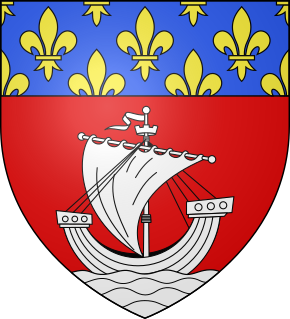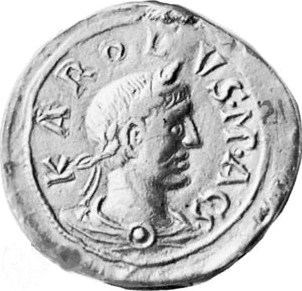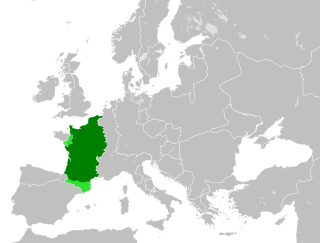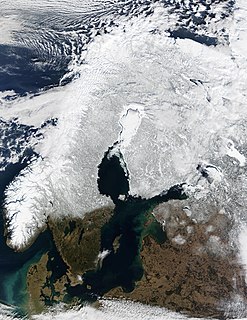
Louis IV, called d'Outremer or Transmarinus, reigned as king of West Francia from 936 to 954. A member of the Carolingian dynasty, he was the only son of king Charles the Simple and his second wife Eadgifu of Wessex, daughter of King Edward the Elder of Wessex. His reign is mostly known thanks to the Annals of Flodoard and the later Historiae of Richerus.

Odo was the elected King of Francia from 888 to 898 as the first king from the Robertian dynasty. Before assuming the kingship, Odo held the title of Count of Paris.

Count of Paris was a title for the local magnate of the district around Paris in Carolingian times. After Hugh Capet was elected King of France in 987, the title merged into the crown and fell into disuse. However, it was later revived by the Orléanist pretenders to the French throne in an attempt to evoke the legacy of Capet and his dynasty.

Charles III, also known as Charles the Fat, was the Carolingian Emperor from 881 to 888. The youngest son of Louis the German and Hemma, Charles was a great-grandson of Charlemagne. He was the second-to-last emperor of the Carolingian dynasty and the last to rule, briefly, over a re-united Frankish empire.

Baldwin I, also known as Baldwin Iron Arm, was the first Margrave of Flanders.
Ranulf II was Count of Poitou from 866 and Duke of Aquitaine from 887. On the death of Charles the Fat in 888, he styled himself King of Aquitaine and did so until 889 or his death, after which the title fell into abeyance.

Richard, Duke of Burgundy (858–921), also known as Richard of Autun or Richard the Justiciar, was Count of Autun from 880 and the first Margrave and Duke of Burgundy. He eventually attained suzerainty over all the counties of Burgundy save Mâcon and by 890 he was referred to as dux (duke) and by 900 as marchio (margrave). By 918 he was being called dux Burgundionem or dux Burgundiae, which probably signified less the existence of a unified Burgundian dukedom than feudal suzerainty over a multiplicity of counties in a specific region.
Alan I, called the Great, was the Count of Vannes and Duke of Brittany from 876 until his death. He was probably also the only King of Brittany to hold that title by a grant of the Emperor.
Al-Mundhir was Emir of Córdoba from 886 to 888. He was a member of the Umayyad dynasty of Al-Andalus, the son of Muhamad bin Abd al-Rahman.

Robert III, also called Robert of Béthune and nicknamed The Lion of Flanders, was the Count of Nevers from 1273 and Count of Flanders from 1305 until his death.

The Kingdom of Upper Burgundy was a Frankish dominion established in 888 by the Welf king Rudolph I of Burgundy on the territory of former Middle Francia. It grew out of the Carolingian margraviate of Transjurane Burgundy southeast of ('beyond') the Jura Mountains together with the adjacent County of Burgundy (Franche-Comté) in the northwest. The adjective 'upper' refers to its location further up the Rhône river, as distinct from Lower Burgundy and also from the Duchy of Burgundy west of the Saône river. Upper Burgundy was reunited with the Kingdom of Lower Burgundy in 933, and eventually merged into the Imperial Kingdom of Arles (Arelat).

In medieval historiography, West Francia or the Kingdom of the West Franks was the western part of Charlemagne's Empire, ruled by the Germanic Franks that forms the earliest stage of the Kingdom of France, lasting from about 840 until 987. West Francia was formed out of the division of the Carolingian Empire in 843 under the Treaty of Verdun after the death of Emperor Louis the Pious and the east–west division which "gradually hardened into the establishment of separate kingdoms (...) of what we can begin to call Germany and France."
Sunyer II was the count of Empúries from 862 and Roussillon from 896 until his death. He was the son of Sunyer I of Empúries

The Kutub al-Sittah are six books containing collections of hadith compiled by six Sunni Muslim scholars in the ninth century CE. They are sometimes referred to as Al-Sihah al-Sittah, which translates as "The Authentic Six". They were first formally grouped and defined by Ibn al-Qaisarani in the 11th century, who added Sunan ibn Majah to the list. Since then, they have enjoyed near-universal acceptance as part of the official canon of Sunni Islam.
Geilo was the Bishop of Langres from 880 until his death. His episcopate coincided mostly with the emperorship of Charles the Fat and after 885 he is a leading ecclesiastical figure at the imperial court. Geilo increased the landholdings and comital rights of the diocese of Langres immensely in his short tenure, a sign of political sagacity. Geilo has been painted as a villain, an ambitious prelate trying to extend his see's temporal authority as far as it could go under the reign of weak Carolingians.
Cynemund was a medieval Bishop of Hereford. He was elected in 888 and died between 888 and 901.
888 is the natural number following 887 and preceding 889.
Áed mac Conchobair was a King of Connacht from the Uí Briúin branch of the Connachta. He was the son of Conchobar mac Taidg Mór, the previous king and was the first of his three sons to rule in succession. He was of the Síl Muiredaig sept of the Uí Briúin. He ruled from 882-888.

The Kingdom of Brittany was a short-lived vassal-state of the Frankish Empire that emerged during the Norman invasions. Its history begins in 851 with Erispoe's claim to kingship. In 856, Erispoe was murdered and succeeded by his cousin Salomon. The kingdom fell into a period of turmoil caused by Norman invasions and a succession dispute between Solomon's murderers: Gurvand and Pascweten. Pascweten's brother, Alan, called the Great, was the third and last to be recognized as king of Brittany. After his death, Brittany fell under Norman occupation. When Alan Twistedbeard, Alan the Great's grandson, reconquered Brittany in 939, Brittany became a duchy until its union with France in 1532.










